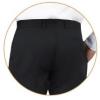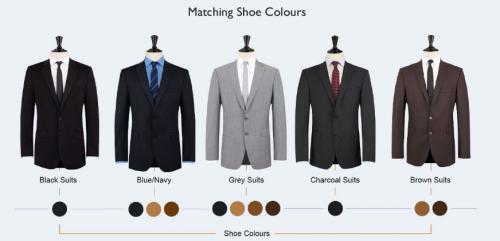Wearing a suit is easy but wearing it well is another thing altogether. With fit, style, accessories and colours to take into equation, it can so easily go wrong. www.dobell.co.uk has created this step by step fitting guide to help you through the process. Follow their advice and you’ll be the best dressed guest at your next wedding.
Fitting Guide
When buying a suit, it's important to check that it fits you properly, both in terms of comfort and style. Below are the crucial areas to check when trying on a suit to ensure it complements your body...
Shoulder
The shoulder fitment of your jacket is one of the most important things to check. The seam should rest naturally on your shoulder, not pull when you move and should not be too wide.
 Jacket Collar
Jacket Collar
The collar of your jacket should fit closely just below the collar of your shirt. It should go across the contour of your back, without being too loose, hanging off or standing away.
Sleeve Length
Your jacket sleeve should be long enough to meet the bumps on your wrist, and your shirt should be a little longer to allow an inch to be visible at the end of the jacket opening.
 Trouser Seat
Trouser Seat
The seat of your trousers is how it fits around your behind. They should fit comfortably, without being too big so that they hang or sag, or too small that they pull tight and dig in.
Jacket Length
A suit jacket should cover most of the zip at the front of your trousers and all of your behind. To test the fit, have your arms at your side and curl your fingers up; the jacket bottom should rest in your hands.
 Trouser Break
Trouser Break
The break of your trousers is where the fold at the bottom meets your shoes. Personal preference may dictate this a little, but your trousers should typically stop a little above halfway up your shoe.
All Tied Up
Ties are the centre-piece of a suit allowing for a little flair and personality. That said, there is a lot to taken into account when pairing a tie with a suit, so follow the below guides to ensure the two are always a winning combination.
Complementary
Focus on matching your ties to your most expensive items first, such as your jackets and shirts. Think about whether the colours and textures will complement the various suits you may own, and how versatile they'll be to work with them all.
Tie Proportions
Ties come in various sizes and lengths, but the width is where people will notice if it looks wrong. In general you want to ensure that your ties measures at around 3-3.5 inches in width or closely matches the width of your lapel.
 Patterns and Colours
Patterns and Colours
There are far too many good combinations to list, but with trial and error you'll be able to find your style. Generally, your tie should always be darker than your shirt and avoid matching patterns. Use a colour wheel to find complementary colours.
 Fabric and Construction
Fabric and Construction
When buying ties, it's recommended to buy the best you can afford to ensure they complement your suit. Silk or cashmere are the most expensive and luxurious, but cheaper alternatives, such as cotton or polyester also do a fine job.
Lapel Types - Anatomy
A jacket is typically the most expensive part of a suit, so when buying one it's important to consider whether or not it will work for its intended occasion. The lapel is key to defining the suit's overall character so pay this special attention.
Variations
Peak Lapel
Peak lapels, summarised by their edges pointing upwards and towards the shoulders are traditionally the most formal lapels, originally common in tailcoats and morning coats.
Occasion: Weddings, formal dinners, black tie events or whenever you want to dress up a bit.
Body Type: For those looking to add some height, the points of a peak lapel can create an elongating effect by moving the eyes upwards.
Notch Lapel
Also known as the 'stepped lapel', the notch lapel is defined by a notch where the bottom of the collar meets the top of the lapel, generally at a 75-90 degree angle.
lapel, generally at a 75-90 degree angle.
Occasion: Everyday work or business suit, great for interviews as well as socialising.
Body Type: Suitable for all body types, but slim notch lapels generally help to flatter and maintain the proportions of a slimmer frame.
Shawl Lapel
Characterised by a single rounded edge, the shawl lapel is most commonly found on dinner jackets and tuxedos, however,  some argue they can also be worn for more informal occasions.
some argue they can also be worn for more informal occasions.
Occasion: Weddings, dinners, black tie events and red carpet galas.
Body Type: Perhaps not recommended if you have a round face or body as this will accentuate those features.
Shoe Combinations - Matching Shoe Colours
Aside from protecting your feet and keeping you comfortable, a good pair of shoes should complement your suit and bring your outfit together, ensuring people's eyes always remain on you and not your feet.
 Shoe Types
Shoe Types
Oxford Shoes
 Oxfords are smart, everyday leather shoes with a relatively low instep and closed lacing. Modern Oxfords may be made from suede or synthetic materials. They are usually plain in design.
Oxfords are smart, everyday leather shoes with a relatively low instep and closed lacing. Modern Oxfords may be made from suede or synthetic materials. They are usually plain in design.
 Derby Shoes
Derby Shoes
Derby shoes are similar in purpose and design to the Oxford but instead sport visible lacing tabs. This makes them appear more casual and, as a result, they are suitable for less formal occasions.
Loafers
Loafers can either be dressy or worn as a sport shoe. Traditionally made from leather, loafers are slip-on shoes that resemble a moccasin on top, distinguished by the lack of laces or buckles.
 Monk Straps
Monk Straps
Monk straps are a versatile dress shoe that are similar to loafers in that they don't have laces. Monk strap shoes have a metallic buckle and a leather strap on the upper portion of the shoe.


Add new comment